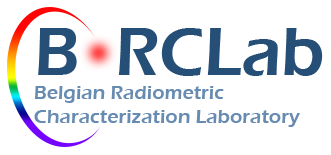SOLAR / SOLSPEC
The mission
SOLar SPECtrometer (SOLSPEC) was one of the SOLAR payload instruments docked to the COLOMBUS module, part of the International Space Station (ISS), from 2008 to 2017 (Figure 1). The instrument consisted in a space qualified spectroradiometer equipped with double monochromators measuring the Solar Spectral Irradiance (SSI) in absolute radiometric units with three independent channels (UV-VIS and NIR), from 166 to 3088 nm. More than 96 % of the energy flow contained in the electromagnetic spectrum of the Sun was measured by SOLAR/SOLSPEC. At this time, it was the unique space experiment able to measure the SSI in absolute units up to 3 µm. SOLAR/SOLSPEC was a French instrument, proposed by the CNRS-SA (Centre National de la Recherche Scientifique – Service d’Aéronomie, now the LATMOS, Laboratoire Atmosphères, Observations Spatiales, France), and accepted by the CNES (Centre National d’Etudes Spatiales, France). The development of SOLSPEC started in the 70’s by a consortium based on the French Institute, BIRA-IASB and the Observatory of Heidelberg (Germany). The first generation of the instrument participated to five space mission in the 80’s and the 90’s in its first design and provided reference solar spectra. The instrument has been completely refurbished for the long-term mission on board the ISS. BIRA-IASB, with the support of BELSPO and the PRODEX Office took a major part of the development of the second generation of SOLSPEC, for mechanics, electronics (IR channel) and complete radiometric characterization.
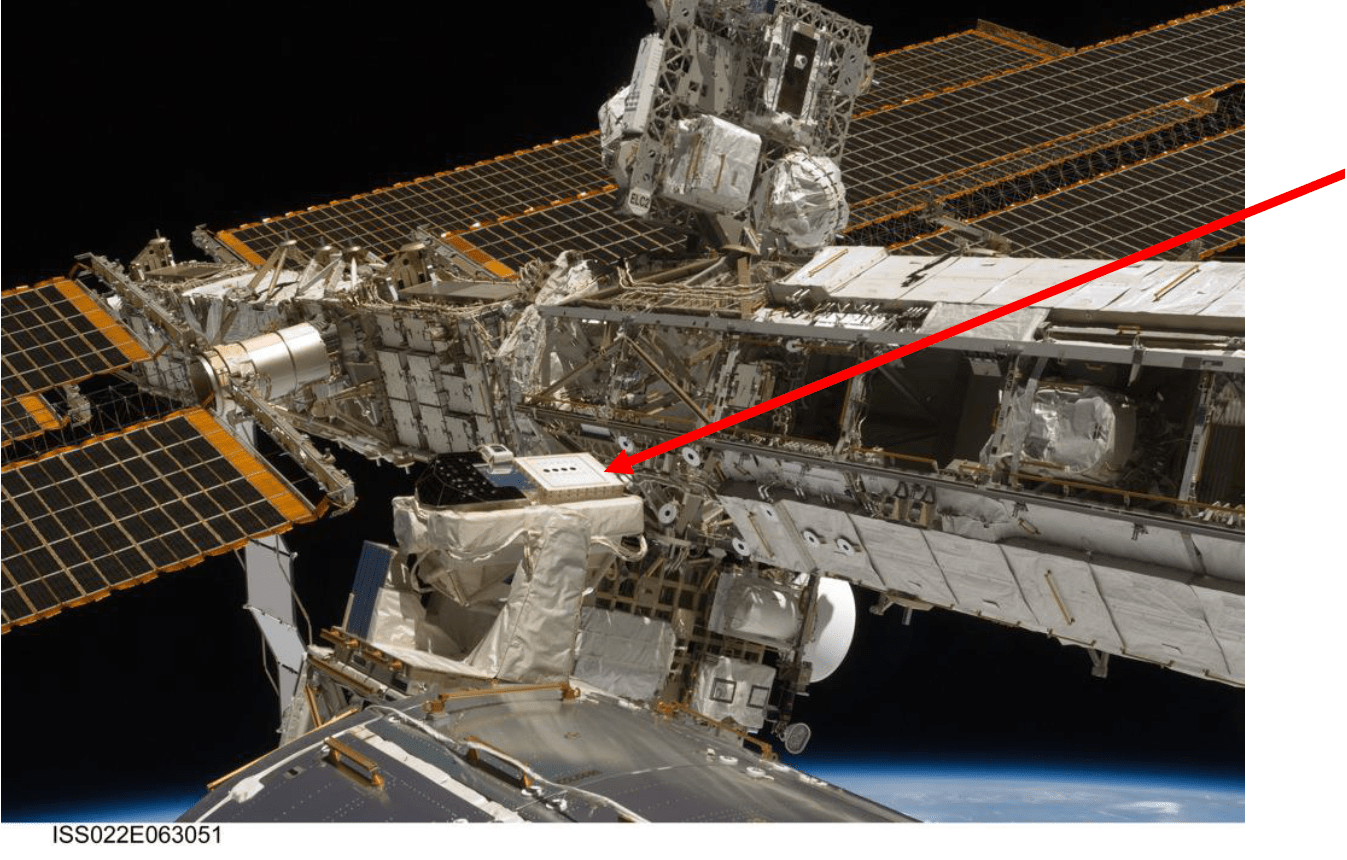
Objectives
Accurate SSI measurements above the atmosphere and their variation in the course of a solar cycle is a key input for the solar physics. It allows the validation of the semi-empirical modelling of the internal physical processes at the origin of the solar emission. It is also a prerequisite for the study of the photochemistry of the Earth’s atmosphere and for climate modelling because the composition and the dynamics of the atmosphere depend spectrally on the incoming solar flux and its variability. Having an absolute calibrated spectroradiometer in space avoids atmospheric absorption.
The Sun irradiance presents some variability, more or less periodical, with increased amplitude for shorter wavelengths. Measurements and modelling are required to better understand the origin of this variability. The SSI should be measured continuously because none of the solar cycles are identical. The monitoring of the SSI variability in function of the wavelength is essential for climatology studies. For example, there is a known coupling between the dynamic of the stratosphere and the troposphere. The consequences are an amplification of the signature of the total solar irradiance variations on the climate. SOLAR/SOLSPEC presented improved capabilities for more accurate SSI measurements with low standard uncertainties and was able to detect the change of SSI in the UV spectral range. Consequently, it contributed to these objectives.
Equipment & software
- Filter wheels: two wheels (UV and VIS-NIR) were installed in front of the spectrometers. They allow four configurations: internal shutters, open position or quartz plate (2 quartz plates per wheel); the quartz plates cover the field of view for shielding against deep UV and X radiations. There was also one filter wheel per spectrometer, between the exit slits and the detectors for second order rejection and attenuation (if required) of the photon flux by means of neutral density filters.
- Detectors: photomultiplier tubes (PMT) in photon counting mode with the photocathode in side window configuration for the UV-VIS (EMR company). Photocathode material: Cs2Te for the UV, tri-alkali for the VIS. The NIR detector was a PbS photodiode (Hamamatsu). This channel used a phase sensitive detection system (Bulova chopper).
- Spectrometers: three double monochromators with concave holographic gratings (wavelength ranges: 166 nm to 371 nm for the UV, 285 nm to 908 nm for the VIS and 647 nm to 3088 nm for the NIR).
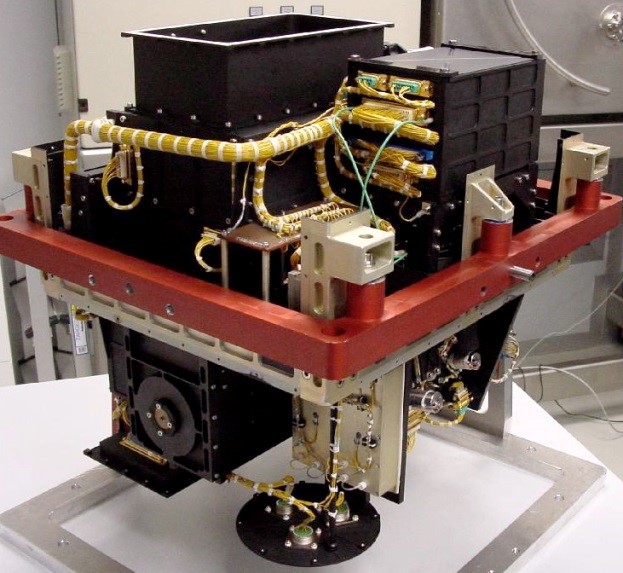
- Internal lamps unit: the aim of this unit was to provide a stable (and redundant) internal light source with a continuous emission in order to detect any long term trend in the absolute calibration of the instrument. Four 4W tungsten lamps were used for the VIS and NIR channels (two per channel), and two deuterium lamps for the UV channel (Figure 3). The accuracy of the wavelength scales was verified using a hollow cathode lamp emitting spectral lines. The optical coupling between the lamps and the entrance slits was performed by means of condensers, fiber optics, mirrors and lenses.
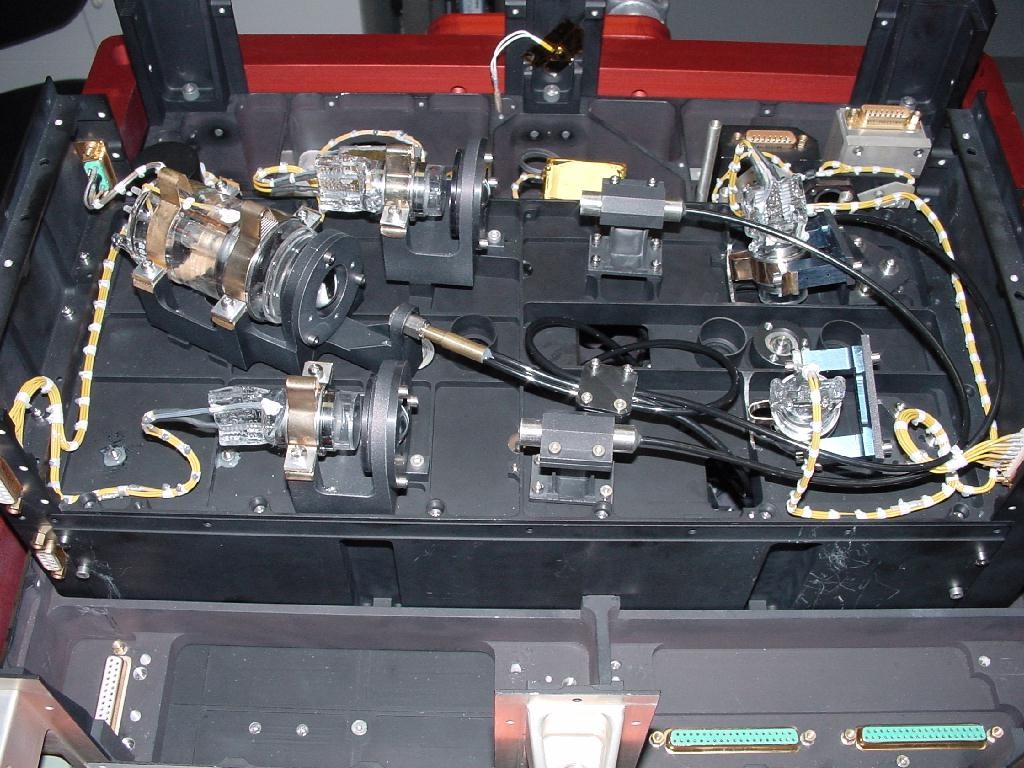
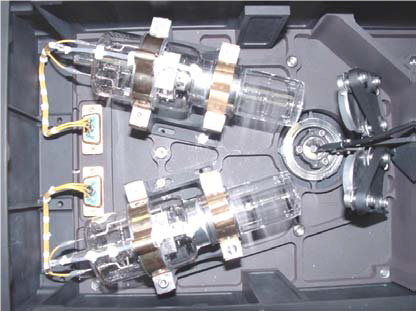
- Passive solar pointer: this module was designed to monitor any misalignment of the Sun with respect to the SOLAR/SOLSPEC optical axis during the Sun tracking performed by the CPD (Coarse Pointing Device) of the SOLAR payload. The module used a PSD (Position Sensitive Device) and an imaging system.
BIRA-IASB SOLSPEC team wrote the flight software. This software never failed during the entire mission and provided for the scientists and operators a large flexibility to operate the instrument in automatic modes.
Characterization of the instrument
The main task of the BIRA-IASB concerning the radiometry was to upgrade the internal lamp unit, to integrate and optically align the double spectrometers, to perform the complete radiometric characterization of the instrument and to contribute to the absolute calibration and uncertainty calculations. The design of SOLSPEC was challenging, as it was the first space instrument measuring the SSI simultaneously in the UV-VIS-NIR spectral ranges. Therefore, it was mandatory to confirm that SOLSPEC was well conceived and robust concerning its opto-mechanical performances. The only (but crucial) condition to fulfill this task was to deeply characterize the instrument before any flight due to the complex thermal behavior and the numerous mobile parts.
- Optical alignment: the integration and optical alignment of the six new gratings ordered for the SOLAR mission was performed at BIRA-IASB (Figure 4). Step by step, gratings were aligned using complex opto-mechanical devices and light sources (continuum and spectral lines).

- Wavelength calibration: the accurate wavelength calibration was performed using spectral lines from He-Ne lasers and spectral lamps to establish the one-to-one relationship between the stepper motor increment and the wavelengths scales (Figure 5).
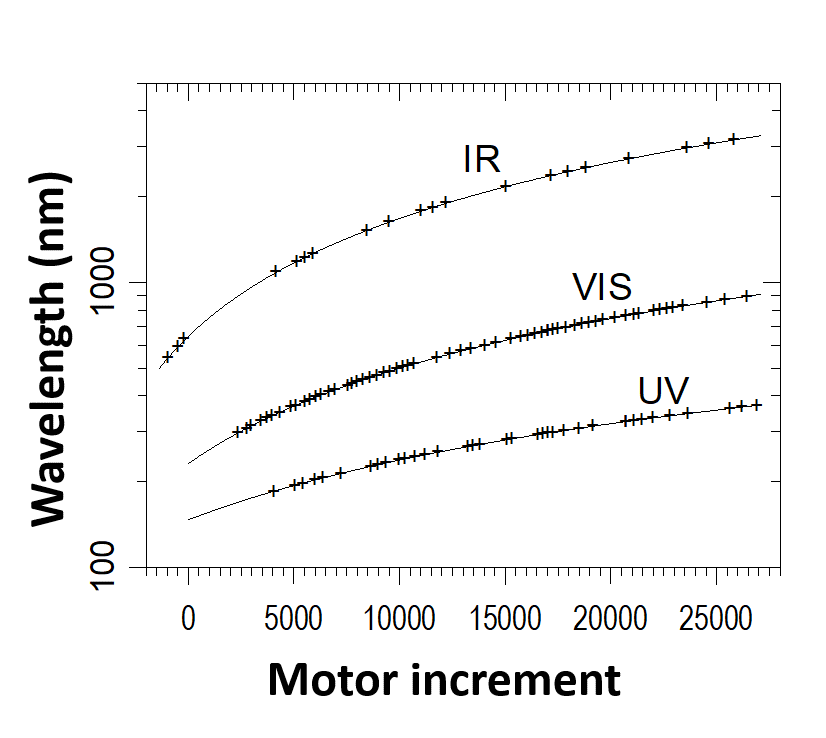
- Non-linearities: the intrinsic non-linearity of the photon counting mode has been characterized for the UV-VIS detecting system using a dedicated facility (Figure 6).

- Additional characterizations: different tasks included the selection of the most suitable filters for the filter wheels, the detailed characterization of the straylight level inside the double monochromators, a detailed study of the slit functions of the spectrometers as well as their shape and their width variation over the spectral ranges. Finally, a detailed study was performed for the angular response of the channels, to determine the amplitude of the correction factors in case of slight depointing of the Sun during the SOLAR mission. The PSD module was also calibrated to rely any displacement of the Sun image on the PSD to an angular misalignment.
- Absolute calibration: The conversion of raw signal into absolute radiometric unit (spectral irradiance) was performed using the blackbody primary standard of the PTB (Germany) for the UV, VIS and NIR channels at atmospheric pressure. The UV calibration under vacuum was performed at BIRA-IASB in a large vacuum chamber using calibrated deuterium lamps provided by the Observatory of Heidelberg.
Results of the SOLAR/SOLSPEC instrument
After 9 years of measurements, the SOLAR mission ended on mid-February 2017 (close to the end of the solar cycle 24). Thanks to the full traceability of the measurements (calibration, characterizations, aging and thermic corrections), the scientists from BIRA-IASB and the LATMOS were able to publish solar reference spectra fully documented, PTB-traceable, in the UV (Bolsée, 2017), VIS and NIR at the minimum of solar activity. They also published UV spectral irradiance variability in the course of the solar cycle 24 (Meftah, 2021). The new reference spectrum SOLAR-ISS (Meftah 2018, 2019) is presented in Figure 7.
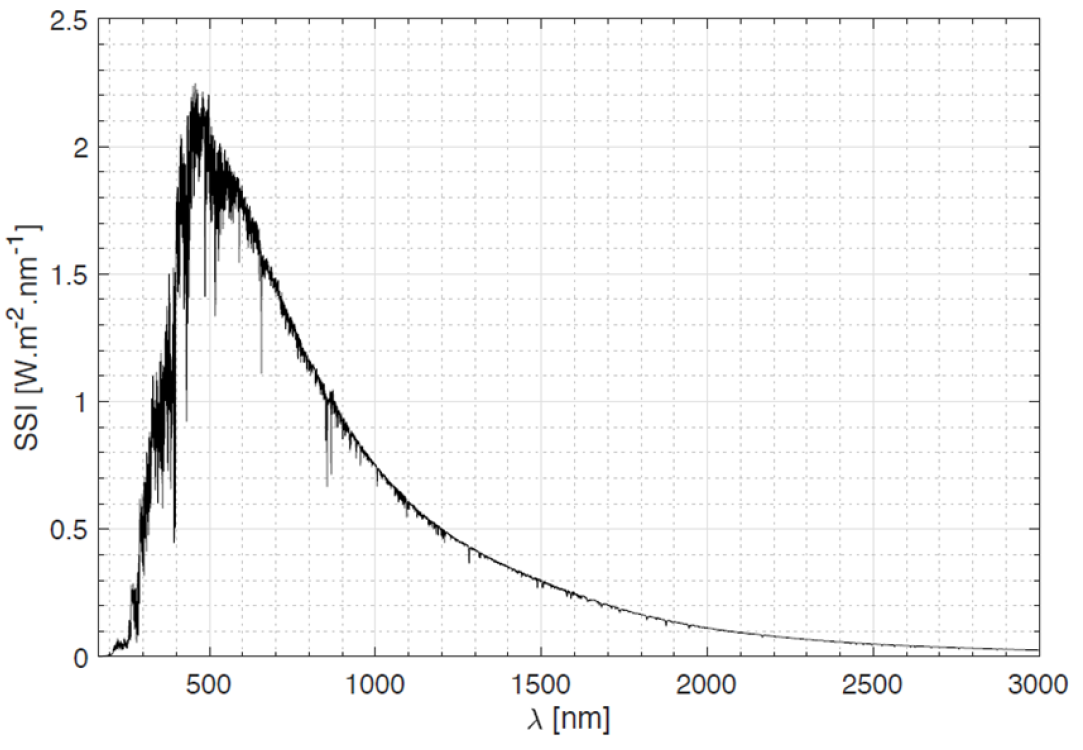
In particular, the BIRA-IASB provided a major contribution to readjust the NIR level of the solar spectral irradiance as defined in the so-called ATLAS 3 solar reference spectrum, thanks to the PYR-ILIOS validation campaign for the NIR measurements of SOLAR/SOLSPEC (Pereira, 2018).
One of the main role of the BIRA-IASB team has been to estimate in detail the standard uncertainties of the solar measurements. This has been possible owing to the full understanding of the instrumentation, the radiometric characterization and the absolute calibration. This work was developed for every measured wavelength (Bolsée, 2012) and integrated in the different publications.
 |
 |
 |
